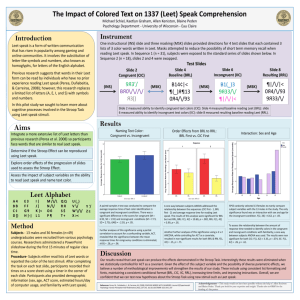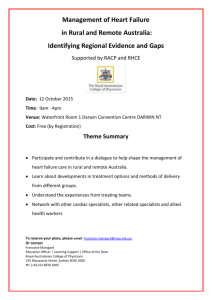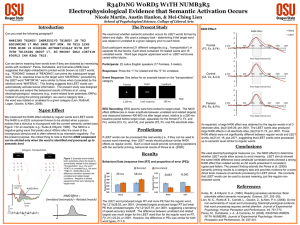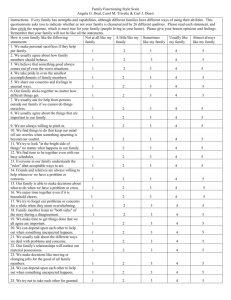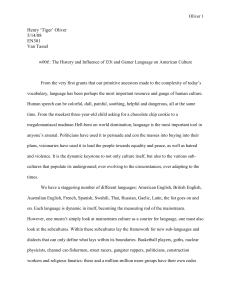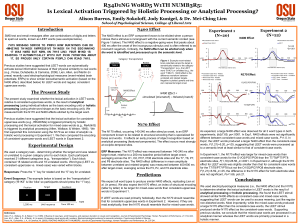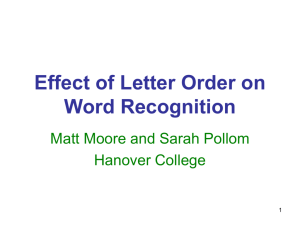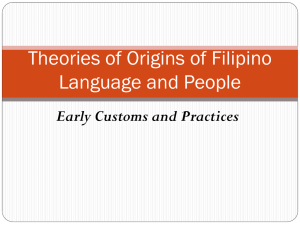GrahamSpr2012
advertisement
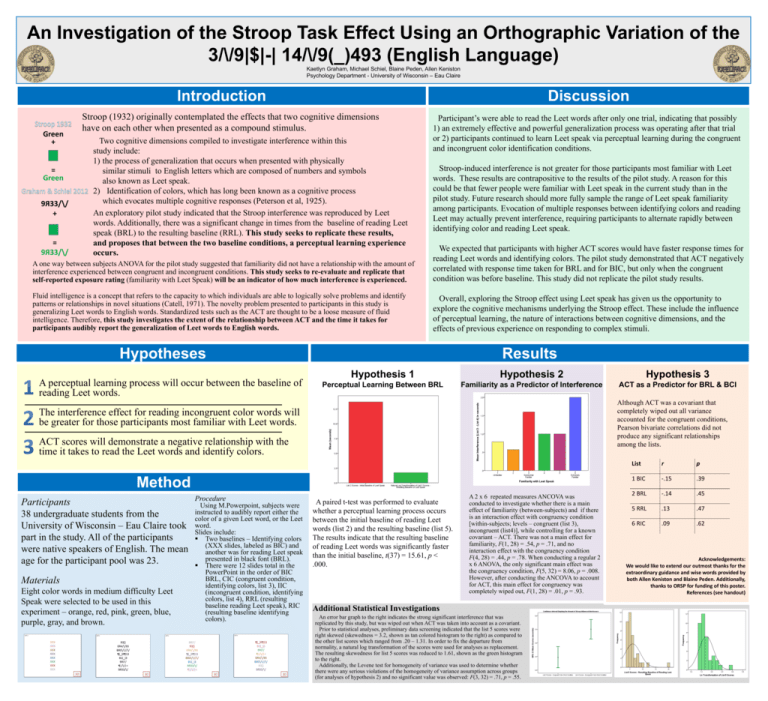
An Investigation of the Stroop Task Effect Using an Orthographic Variation of the 3/\/9|$|-| 14/\/9(_)493 (English Language) Kaetlyn Graham, Michael Schiel, Blaine Peden, Allen Keniston Psychology Department - University of Wisconsin – Eau Claire Introduction Green + = Green 9Я33/\/ + = 9Я33/\/ Discussion Stroop (1932) originally contemplated the effects that two cognitive dimensions have on each other when presented as a compound stimulus. Two cognitive dimensions compiled to investigate interference within this study include: 1) the process of generalization that occurs when presented with physically similar stimuli to English letters which are composed of numbers and symbols also known as Leet speak. 2) Identification of colors, which has long been known as a cognitive process which evocates multiple cognitive responses (Peterson et al, 1925). An exploratory pilot study indicated that the Stroop interference was reproduced by Leet words. Additionally, there was a significant change in times from the baseline of reading Leet speak (BRL) to the resulting baseline (RRL). This study seeks to replicate these results, and proposes that between the two baseline conditions, a perceptual learning experience occurs. Participant’s were able to read the Leet words after only one trial, indicating that possibly 1) an extremely effective and powerful generalization process was operating after that trial or 2) participants continued to learn Leet speak via perceptual learning during the congruent and incongruent color identification conditions. Stroop-induced interference is not greater for those participants most familiar with Leet words. These results are contrapositive to the results of the pilot study. A reason for this could be that fewer people were familiar with Leet speak in the current study than in the pilot study. Future research should more fully sample the range of Leet speak familiarity among participants. Evocation of multiple responses between identifying colors and reading Leet may actually prevent interference, requiring participants to alternate rapidly between identifying color and reading Leet speak. A one way between subjects ANOVA for the pilot study suggested that familiarity did not have a relationship with the amount of interference experienced between congruent and incongruent conditions. This study seeks to re-evaluate and replicate that self-reported exposure rating (familiarity with Leet Speak) will be an indicator of how much interference is experienced. We expected that participants with higher ACT scores would have faster response times for reading Leet words and identifying colors. The pilot study demonstrated that ACT negatively correlated with response time taken for BRL and for BIC, but only when the congruent condition was before baseline. This study did not replicate the pilot study results. Fluid intelligence is a concept that refers to the capacity to which individuals are able to logically solve problems and identify patterns or relationships in novel situations (Catell, 1971). The novelty problem presented to participants in this study is generalizing Leet words to English words. Standardized tests such as the ACT are thought to be a loose measure of fluid intelligence. Therefore, this study investigates the extent of the relationship between ACT and the time it takes for participants audibly report the generalization of Leet words to English words. Overall, exploring the Stroop effect using Leet speak has given us the opportunity to explore the cognitive mechanisms underlying the Stroop effect. These include the influence of perceptual learning, the nature of interactions between cognitive dimensions, and the effects of previous experience on responding to complex stimuli. Hypotheses A perceptual learning process will occur between the baseline of reading Leet words. Results Hypothesis 1 Hypothesis 2 Hypothesis 3 Perceptual Learning Between BRL Familiarity as a Predictor of Interference ACT as a Predictor for BRL & BCI Although ACT was a covariant that completely wiped out all variance accounted for the congruent conditions, Pearson bivariate correlations did not produce any significant relationships among the lists. The interference effect for reading incongruent color words will be greater for those participants most familiar with Leet words. ACT scores will demonstrate a negative relationship with the time it takes to read the Leet words and identify colors. Methods Method Participants 38 undergraduate students from the University of Wisconsin – Eau Claire took part in the study. All of the participants were native speakers of English. The mean age for the participant pool was 23. Materials Eight color words in medium difficulty Leet Speak were selected to be used in this experiment – orange, red, pink, green, blue, purple, gray, and brown. Procedure Using M.Powerpoint, subjects were instructed to audibly report either the color of a given Leet word, or the Leet word. Slides include: Two baselines – Identifying colors (XXX slides, labeled as BIC) and another was for reading Leet speak presented in black font (BRL). There were 12 slides total in the PowerPoint in the order of BIC BRL, CIC (congruent condition, identifying colors, list 3), IIC (incongruent condition, identifying colors, list 4), RRL (resulting baseline reading Leet speak), RIC (resulting baseline identifying colors). A paired t-test was performed to evaluate whether a perceptual learning process occurs between the initial baseline of reading Leet words (list 2) and the resulting baseline (list 5). The results indicate that the resulting baseline of reading Leet words was significantly faster than the initial baseline, t(37) = 15.61, p < .000. A 2 x 6 repeated measures ANCOVA was conducted to investigate whether there is a main effect of familiarity (between-subjects) and if there is an interaction effect with congruency condition [within-subjects; levels – congruent (list 3), incongruent (list4)], while controlling for a known covariant – ACT. There was not a main effect for familiarity, F(1, 28) = .54, p = .71, and no interaction effect with the congruency condition F(4, 28) = .44, p = .78. When conducting a regular 2 x 6 ANOVA, the only significant main effect was the congruency condition, F(5, 32) = 8.06, p = .008. However, after conducting the ANCOVA to account for ACT, this main effect for congruency was completely wiped out, F(1, 28) = .01, p = .93. List r p 1 BIC -.15 .39 2 BRL -.14 .45 5 RRL .13 .47 6 RIC .09 .62 Acknowledgements: We would like to extend our outmost thanks for the extraordinary guidance and wise words provided by both Allen Keniston and Blaine Peden. Additionally, thanks to ORSP for funding of this poster. References (see handout) : Additional Statistical Investigations An error bar graph to the right indicates the strong significant interference that was replicated by this study, but was wiped out when ACT was taken into account as a covariant. Prior to statistical analyses, preliminary data screening indicated that the list 5 scores were right skewed (skewedness = 3.2, shown as tan colored histogram to the right) as compared to the other list scores which ranged from .20 – 1.31. In order to fix the departure from normality, a natural log transformation of the scores were used for analyses as replacement. The resulting skewedness for list 5 scores was reduced to 1.61, shown as the green histogram to the right. Additionally, the Levene test for homogeneity of variance was used to determine whether there were any serious violations of the homogeneity of variance assumption across groups (for analyses of hypothesis 2) and no significant value was observed: F(3, 32) = .71, p = .55.
